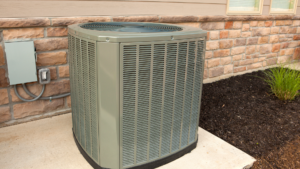
Energy Efficiency Ratio
An air conditioner’s Energy Efficiency Ratio (EER) measures cooling output versus power input: how much cold air it produces every hour compared to the amount of electricity it consumes. Calculating EER is simple. Divide the air conditioner’s BTUs by its wattage. The higher the ratio, the more efficient the unit.
For example, a unit with an 18,000 BTU capacity and a 1,000 watt energy usage would have an EER of 18 (18,000/1,000 = 18), while a unit with a capacity of 24,000 BTU and 2,000 watt energy usage would have an EER of 12. Most air containers list their wattage and BTUs in the owner’s manual or on the side of the unit, so you can determine its EER without much difficulty. The average air conditioner has an EER of 8.5
Though EER is a helpful indicator, it assumes a constant external and internal temperature. Most homes, however, experience significant temperature swings over the course of a year or even within a single season. Heat waves and temperature spikes have a serious impact on cooling costs, which is why many manufacturers prefer to market their products using their Seasonal Energy Efficiency Ratio (SEER) instead.
Manufacturers calculate SEER by measuring an air conditioner’s energy output over a range of temperatures, then adding them together and dividing by the unit’s total energy consumption. A central air conditioner with a total output of 36,000 BTUs and a total input of 6,000 watts would have an SEER of 6. Again, the higher the number, the more efficient the unit. Comparing an air conditioner’s EER with its SEER gives you a good indication of how well it runs under ideal versus practical conditions.
Cost Per Hour
Despite the utility of EER and SEER, the most reliable and widely used metric is cost-per-hour. To calculate, multiply the unit wattage by the price of electricity in your state and divide by 1,000.
Utilities don’t measure energy consumption in watts, but in kilowatt hours (kWh) ‒ the amount of energy consumed by a 1,000 watt appliance if you were to run it continuously for 60 minutes. It would take a 10 watt lightbulb 100 hours to use up one kWh, while a 2,000 watt generator would burn through it in half an hour. Dividing by 1,000 converts the AC’s wattage into kWh, giving you an accurate estimate of its operating cost.
(Watts x Price per kWh) / 1,000 = Cost
Because the price of electricity varies widely from state to state, this formula gives you the clearest look at your air conditioner’s true cost. However, it’s important to keep in mind that central air conditioners don’t run continuously over the course of an hour. They operate in 15-20 minute cycles instead, only switching on when the temperature rises above your desired level. 70-80 percent of the time they’re active and 20-30 percent of the time they’re idle. Factoring this in makes it easier to assess your costs and budget accordingly.
Additional Considerations
When determining how much it costs to run a central air conditioner, efficiency and electricity rates aren’t the only factors. You also need to account for:
- Condition of the Unit. Air conditioners tend to become less efficient as they age. Their components gradually wear down, requiring them to work longer in order to maintain a comfortable temperature. Regular maintenance helps ensure the unit runs efficiently and often extends its lifespan.
- Quality of Your Insulation. Insulation prevents energy loss. Tattered and threadbare insulation allows cool air to escape, which puts additional strain on your air conditioner.
- Thermostat Settings. The lower you set your thermostat, the harder your air conditioner has to work to maintain your desired temperature. For maximum efficiency, never set your thermostat more than 20°F below the temperature outside.
- Climate. Heat and humidity have a huge impact on your air conditioning. Homes in areas with extreme temperatures require units with a higher BTU capacity than homes in areas with moderate temperatures. Humid air also holds more heat than dry air, so it’s more expensive to run air conditioners in humid climates than in dry ones.
- Cooling Schedule. Not surprisingly, how often you run your air conditioning has a huge impact on its overall cost. Instead of maintaining a single temperature throughout the day, adjust your settings to concentrate energy when temperatures are at their peak. Installing a smart thermostat simplifies the process. It automatically modifies its settings according to your habits: raising temperatures when you leave for work or school then lowering them when you get home, for instance.
Save Money on Air Conditioning Repairs
The cost of running a central air conditioner is small compared to the cost of repairing one. Replacement parts can easily cost hundreds of dollars. Don’t let a breakdown derail your budget. Home insurance doesn’t cover wear and tear, but Agway’s EnergyGuardTM Program does.
EnergyGuardTM protects your heating, cooling, and electrical systems* from damage resulting from regular use. When the need for repair occurs, our customers don’t have to worry about finding a technician they can trust. We maintain a network of skilled, local contractors and send the first available straight to your door. There are no deductibles or service fees. Our team pays for the visit and all covered parts. Sign up to start enjoying the benefits of EnergyGuardTM today!